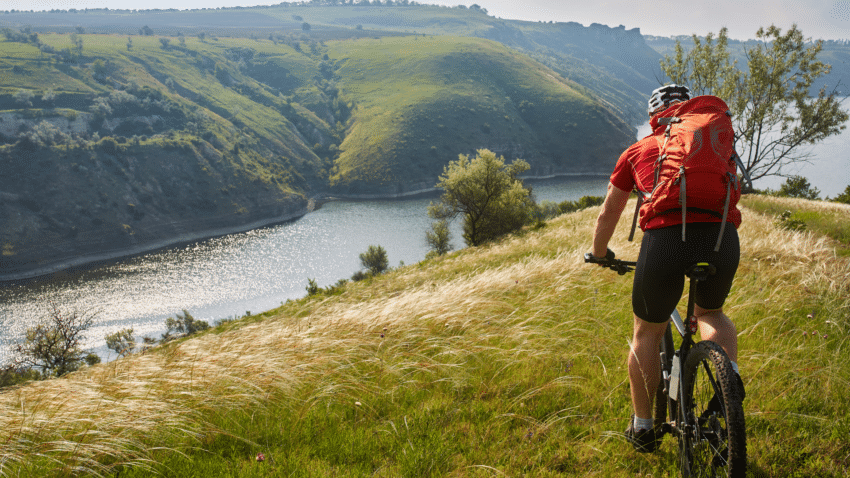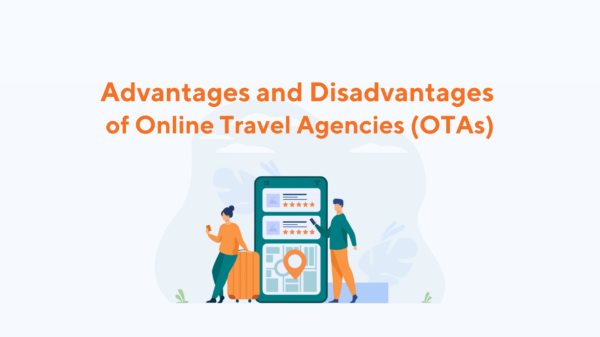The phrase “the new normal” has become a bit of a cliché over the last 18 months or so, with good reason. What is normal today may not be normal next week, or even tomorrow, as the world slowly starts to recover from the COVID-19 pandemic.

The travel and tourism industry is no exception. While the global uncertainty makes predictions difficult, a few trends are sure to impact tour companies in 2022. Each one contains opportunities for tour companies to adapt to meet the changing needs and demands of travellers, and adjust to regulations, health protocols, and other effects of the pandemic on the global travel industry. Here are some to keep an eye on.
1. Physical-distancing while travelling

Even if governments lift restrictions completely in many countries in 2022, it will take a while for a lot of people to feel comfortable in crowded streets or attractions, on public transport, or even just in an elevator with more than a couple of people.
COVID-19 will still be circulating in 2022, and vaccination rates will differ country to country—as will safety protocols. Many travellers want reassurance that they will be able to distance themselves from others while enjoying the sights at their chosen destination. For tour operators, that means considering how your customers will get around at their destination. For example, would a rental car be better than relying on public transport? The attractions included in the itinerary are also critical. For example, could you focus on outdoor attractions where virus transmission is less of a risk, or include off-the-beaten-track activities that are likely to be less crowded?
People will have a desire to feel as safe as possible as they tentatively begin travelling again. It’s up to tour operators to get creative when it comes to anticipating and easing these early fears to help ensure a successful restart of the global travel and tourism industry.
2. Continued desire to travel in “bubbles”
In 2022, more risk-averse people may want to continue to avoid mixing with other people much while travelling. They may want to travel in a bubble of their own, reducing or even eliminating contact with those outside their bubble to reduce the risk of COVID-19 transmission.

RV and camper van sales have gone through the roof since the pandemic hit. Road-tripping and other travel that minimizes contact is likely to still be in high demand in 2022. Travel to more remote, less populated destinations could also appeal to the more safety-conscious traveller as we emerge from COVID-19. At the same time, huge, popular attractions renowned for their bustling crowds may not see a quick return to their pre-COVID popularity. Instead of hotels, there could also be more demand for self-contained accommodation such as cottages and rental apartments. This could be a good time to set new pick-up and drop-off locations in your booking system, which is something Rezgo lets you do.
All of this creates an opportunity for travel agents to create small group tours tailored to people who know each other, or to focus more on FIT (free independent travellers) tours (see below).
3. Opportunities in FIT travel
FIT travellers march to the beat of their own drum, eschewing group tours, all-inclusive vacations, and mass tourism. Ranging from Gen Zers and Millennials to empty nesters and retirees, they want to plan their own trip and do things at their own speed and on their own schedule.

While these lone wolves use the Internet to research and often book their travel, even the most independent-minded travellers are open to advice from experts. COVID-19 has made the idea of getting some additional advice during the planning of a trip even more attractive to FIT travellers. Knowing how quickly things can change during the pandemic, people are more conscious of where they get their information. An effective website can help tour operators position themselves as authorities on particular destinations and activities, and a trusted source of advice.
There could be opportunities for tour operators to focus more on FIT travellers, offering trip planning and specific destination- and activity-focused services. The benefit to these customers is they can still take an independent trip, free from the constraints of group or package tours, but they can save time and stress doing all of the planning and booking themselves.
They can also feel more secure knowing they took advice from a source with the inside track on a particular destination or activity.
4. Staying connected before and during travel
In April 2020, not long after the pandemic hit, a story appeared in the media about a hiker in New Zealand who emerged from a multi-day, off-grid wilderness tramp into a different world. In between starting his hike and returning, the entire country had gone into lockdown. With no phone connection, he had no idea that everyone in New Zealand was now effectively confined to their neighbourhoods and homes.

There were many other stories from around the world of people getting stranded in countries or having to scramble to find a way home. Now that everyone knows what can happen during a pandemic, and how quickly things can change without much or even any notice, travellers will be wary of getting caught off-guard.
It’s important for tour operators to continue to keep customers abreast of any changes, or potential changes, to their plans. They’ll appreciate any updates you can provide in advance of their trip, for example on the latest tightening or relaxing of restrictions at their destination, so they can feel prepared and informed. Knowing their tour operator is looking out for them with a pre-trip email can help put customers minds’ at ease, increasing their satisfaction with your service and attention to detail.
Tour operators should also keep up this dialogue during the trip, and be available for questions and advice if something happens that could impact their guests’ travel plans. Winning back trust is vital to help kick-start the tourism industry.
5. The return of business travel

According to a McKinsey report, in 2020 total global business travel expenses were down 52%. In the US, corporate travel spending dropped by 71%—a loss to the industry of $94bn. While McKinsey initially predicted a slow and difficult recovery for corporate travel, the rapid development of viable vaccines and the rise in vaccination rates has increased the likelihood of a faster rebound.
While the rise of video conferencing and a new acceptance of work-from-home arrangements still creates some uncertainty around the future of corporate travel, McKinsey highlighted four segments to watch:
- “Never left”: Employees who have to travel and who began travelling again as soon as restrictions began to be lifted.
- “Never returning”: Video conferencing and remote working could change the face of work forever, including when people travel for business. There will be companies that now see it as an unnecessary expense, and—at least in the short-term—a potential health risk.
- “Fear of missing out” (FOMO): McKinsey sees this group as key to the successful return of corporate travel. Many businesses will still want to travel to maintain client relationships, win contracts, and keep up with the competition.
- “Wait and see”: Businesses that don’t need to travel, but travelled now and then for conferences and other events, may be the slowest to start planning corporate travel again. They may stick to virtual events for a while.
The last two segments in particular are worth focusing on, especially the FOMO segment. These more frequent travellers are eager to begin travelling for business again.
6. New types of “bleisure” travellers
While corporate travel goes through a period of recovery, tour operators can target another type of business traveller to fill the gap. “Bleisure” travellers—people taking extended trips combining work and recreation, or remote workers who can work anywhere anytime—could be a growth area.

While this group used to include mostly young “digital nomads,” the growth of online collaboration tools, cloud computing, video conferencing, and other digital innovations enables more people to work from almost anywhere. During the pandemic, these tools have become ubiquitous, and companies are now more able to offer flexibility for remote working to some employees. This creates an opportunity to create “workcation” experiences for people who have the means and ability to work remotely.
This includes promoting interesting destinations. A report by Ogilvy Consulting highlighted opportunities to promote “rebel cities,” such as Athens, Dakar, Medellin, Brisbane, and Chengdu, to “establish themselves as renegade destinations with rich cultures and a high quality of life, while boasting better value and with more ‘off-the-beaten path’ credentials than the usual suspects of Paris, New York, and Berlin.”
Keep an eye out for campaigns from Destination Marketing Organizations and Destination Management Companies around emerging destinations to see if you can create some new tours.
7. Rethinking destinations
As well as creating tours to emerging destinations that could cater to new types of traveller, countries that managed the pandemic well and that have high vaccination rates could be in demand. For example, New Zealand gained a lot of praise for its handling of the pandemic, while Canada and the UK rolled out vaccination programs that were internationally recognized as successful. These countries could feel “safer” to travellers than other destinations that haven’t controlled the pandemic as well.

On the flipside, countries that still struggle with the pandemic—including previously very popular destinations—could see a decline in popularity. Tour operators need to be able to answer what is likely to be a common question from customers: “Where is safe for me to travel?” Of course health advice isn’t part of your remit, but if there’s a perception that your destination isn’t safe, you should be prepared to take extra steps to reassure international guests.
8. Changes to how people travel—and how far

As well as where people want to travel, how they get there could be on the minds of travellers. Many people may still be nervous about flying, so look out for a continued demand for “low travel,” such as travel by road and rail. Even people who are willing to fly to their destination may want to choose ground travel to be able to physically distance, open windows, take breaks outside, etc.
Those that are happy to fly may still be picky about which airline to travel with and will want to know about their approach to safety and standards of hygiene.
One bright spot could be a growth in long-haul travel in 2022 compared to 2021 and 2020, as more borders open up and people feel more comfortable travelling farther for a once-in-a-lifetime trip they’ve saved up for or just to reunite with far-flung relatives and friends. However, “staycations” are likely to remain a popular option for many people. Many people have realized that exploring your own city or country can be as rewarding as a trip abroad, so don’t forget to market more local trips to people in your own backyard.

9. Emerging and continuing niches
A number of travel niches emerged during the pandemic, requiring tour operators to get creative. See 15 Innovative Tourism Business Ideas for a selection of these. Some are likely to remain popular in 2022, including the previously mentioned “staycations,” and “travel bubbles,” as well as solo travel, environmentally-conscious travel, bucket-list travel, and “glamping.”
As borders hopefully continue to open up, restrictions are lifted, and people feel safe enough to travel, three other niches worth paying close attention in 2022 include:
Reunion travel: There is huge, pent-up demand for travel to reunite with family members and friends abroad. These travellers may not want to travel much within a destination, preferring to spend quality time with loved ones. Focus on making sure you offer (and market) opportunities for making amazing family memories.
Nostalgia travel: A sub-sector of reunion travel could be “nostalgia travel”—where groups of old friends reunite on a trip or couples travel to their favourite destination, such as where they met, got married, or had their honeymoon.
Quest for adventure: An article in travel publication euronews.travel quoted travel experts who had noticed an increase in demand for one-off adventurous vacations, especially to the great outdoors. As one expert quoted in the article said, “Life’s so short and we all appreciate that now more than ever before, and we’re seeing that reflected in what people are booking.”

10. How people book travel
One development that you can predict with certainty, whether it happens in 2022 or 2023, is a huge demand for travel once vaccination rates lead to herd immunity, which is when a large enough proportion of the population is immune to COVID-19 that everyone is protected. Even before global herd immunity is achieved, “vaccination passports” are already enabling travel to countries with high vaccination rates.
The upshot will be an explosion of demand from people who haven’t been able to travel for a long time. Tour operators will need robust booking systems and processes to cope with a high volume of bookings at the same time. And travellers who are eager to take that long-awaiting trip won’t want to wait, so online booking is more important than ever. .
Are you ready for the road ahead in 2022?
At Rezgo, we always aim to keep ahead of the latest tourism trends and business opportunities. Rezgo is a comprehensive booking platform that can help you future-proof your business so you can develop and grow as the tourism industry changes. Try a demo today to see what 2022 could hold for your business as the world opens up.
Search The Blog
Most Popular Articles
- 16 Innovative Tourism Business Ideas and Trends for 2025
- Your Marketing Mix: the 7 Ps of Travel and Tourism Marketing
- How to Get the Most Out of Guest Satisfaction Surveys
- Advantages and Disadvantages of Online Travel Agencies (OTAs)
- A Guide to Hiring in Tourism: Skills, Strategies, and Seasonal Staff





